Photographs, captions, and commentary by Jacqueline Banerjee. You may use these images without prior permission for any scholarly or educational purpose as long as you (1) credit the photographer and (2) link your document to this URL in a web document or cite the Victorian Web in a print one. [Click on all the images to enlarge them.]

The Grange, next to St Augustine's Church. Augustus Welby Pugin (1812-1852), with some later alterations and additions by Edward, Peter Paul, and Cuthbert Pugin. Yellow brick with stone dressings. Main work, 1844-45, now faithfully restored by The Landmark Trust. St Augustine's Road, Ramsgate, Kent.



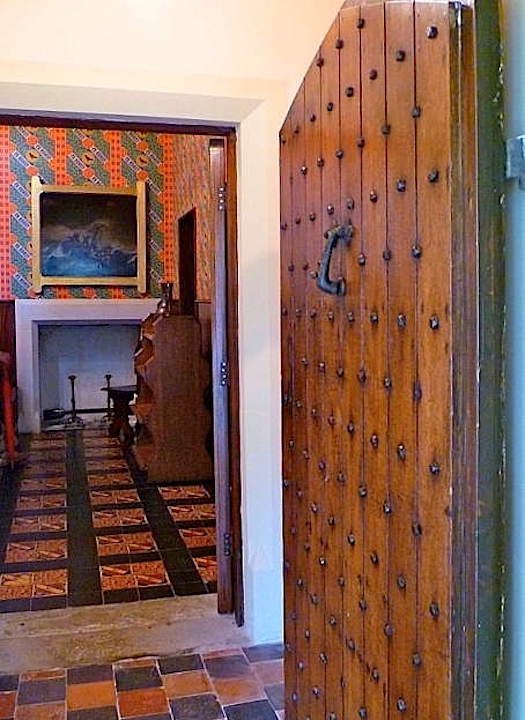
Left to right: (a) Entrance gates to The Grange, added by Pugin's eldest son, Edward. (b) North Courtyard: this space also owes much to Edward Pugin. (c) Approaching the front door through Edward Pugin's covered walkway. (d) Augustus Pugin's stout, studded front door.
The Grange, part of a complex that includes St Augustine's Church, St Edward's Presbytery and the Cartoon Room or stained-glass studio, was the second home that Pugin built for himself. The first was St Marie's Grange, Aldebury, near Salisbury. Originally a fortress-like building, built in 1835 and sold by auction in 1841, this earlier house has been much altered, and remains in private hands today. During his years there, however, Pugin had useful practice in building plainer houses, mostly for the clergy, and came to prefer simpler designs (see Hill 292). So there is no whimsical dry moat and drawbridge arrangement in this second Grange. From the outside, some reminders of the first house are the protection of the family home within an inner courtyard (hence the rear view here); the little chapel projecting to the east, and the stout tower adorned with battlements. The latter feature is not just a fanciful medieval flourish: it houses the water tanks, and was also very useful to Pugin in his role as sailor-salvager, commanding wonderful views across the coast. The house used to be entered from an alley by a small side gate, until the more status-conscious Edward Pugin added the present large gates with a pair of heraldic lions on its gateposts. Edward also added the extended porch or timber-and-glass walkway leading to the front door. The door itself is Pugin's own, stout and iron-studded, further evidence of his lifelong dread of burglars.
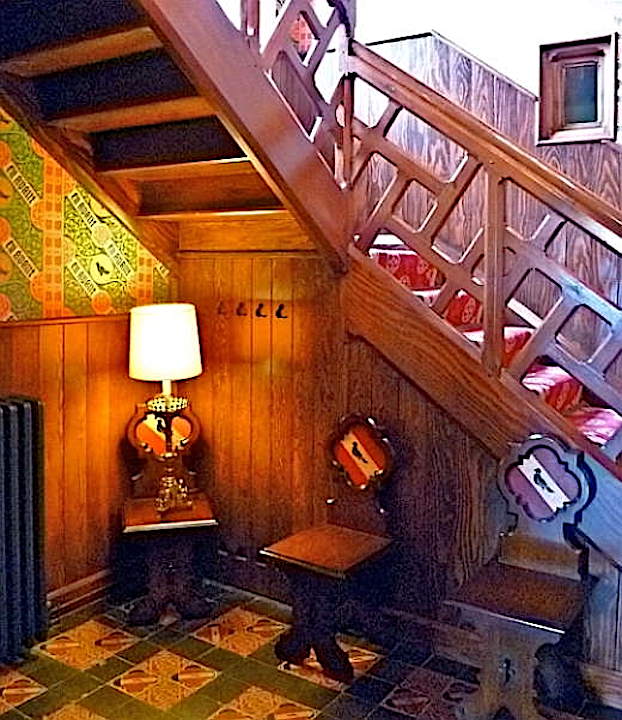
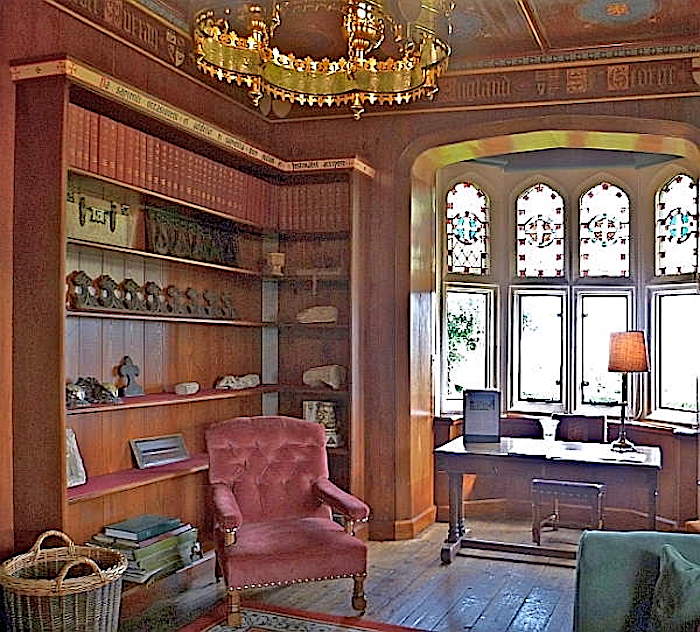
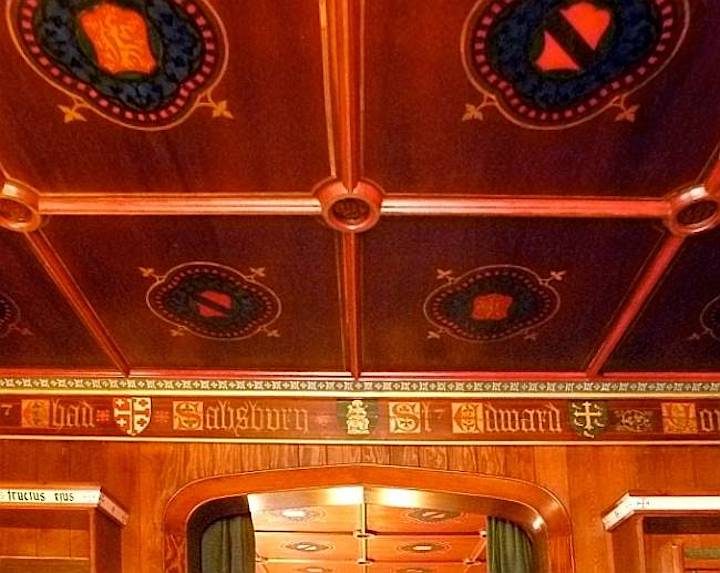
Left to right: (a) A corner of the hallway. The openwork of the balustrade relieves the rather overwhelming effect of the typical Pugin wallpaper, the martlets (heraldic birds) on which are echoed in the hall chairs. These chairs are copies, but an original chair is exhibited in the Walker Gallery in Liverpool. (b) The library, showing where Pugin would work with his patron saints looking down on him from the stained-glass lights in the upper part of the bay window. (c) The compartmented ceiling, with a shield in each square, continues on into the sitting room on the other side of the green curtain: Pugin preferred this arrangement to a door, which might slam.
The most striking feature about the interior is the large hallway; all the main downstairs rooms open off it This plan might seem perfectly "rational" now (Newman 424), but only with hindsight. Pugin had created a superb galleried "Great Hall" for Scarisbrick Hall in Lancashire, but for himself he was just designing a small house, where family and servants would all be constantly coming and going in the same space. The fundamentally Gothic feature was revolutionary in such a context, but it was to prove practical and popular in later Victorian housing. For instance, a similarly large hallway is found in a house at Norham Gardens, North Oxford, on an estate where Pugin's inspiration has been acknowledged (see Long 5). But many, many people still live in Victorian or later homes with this kind of hallway. "The staircase itself, rising round three walls to a first floor balcony, is of Georgian generosity," continues John Newman, who then goes to the other side of the world to describe the "balustrading of panels of diagonal braces" as "à la chinoise" (424-5). In fact, as a later footnote points out, the attractive open-work pattern comes from old timber-framed houses in France, as shown in Pugin's own earlier Details of Antient Timber Houses (1837). Such puzzlement is proof, if any is needed, of how unusual this staircase was for its time.
Of the rooms opening off the hall, the most important is the library, described by Pugin's young assistant John Hardman Powell as "the most picturesque room in the house," where Pugin had his drawing board by the beautiful bay window. "Around the cornice are the Arms of his special friends; the walls are shelved for his multitude of sketches and books of reference, 'all handy'. And here he worked, only interrupted by chapel, food and daily walk" (Powell 13).
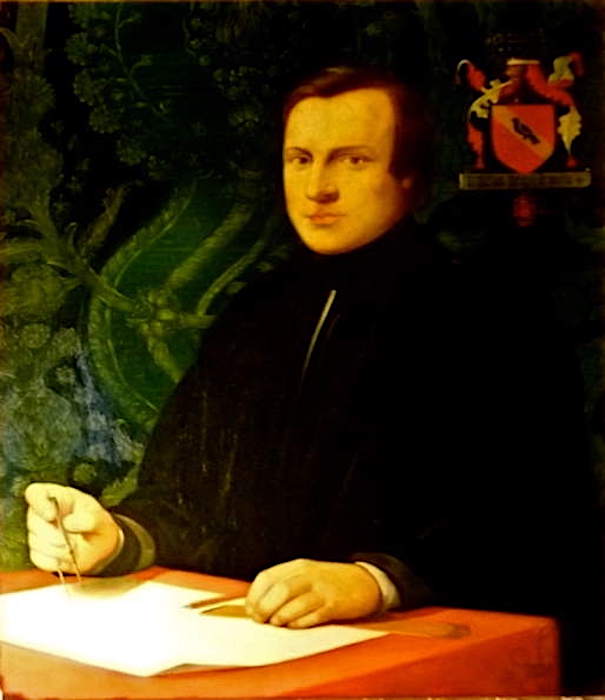
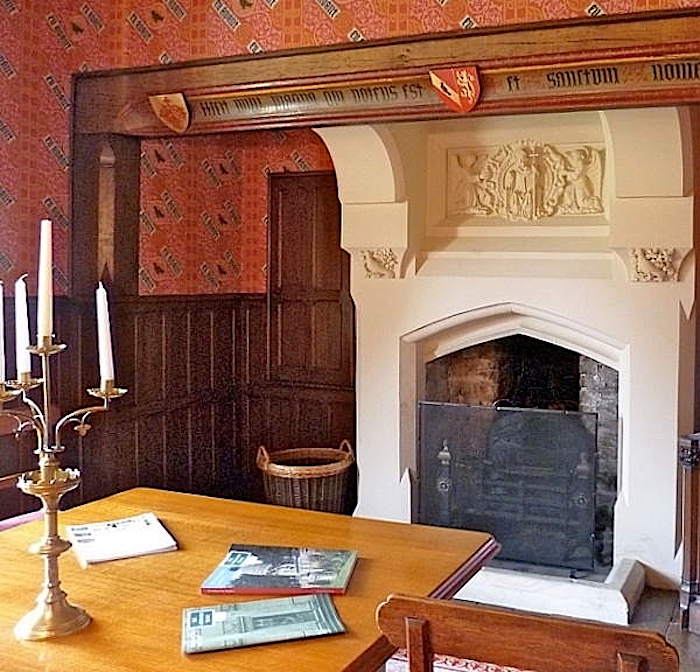
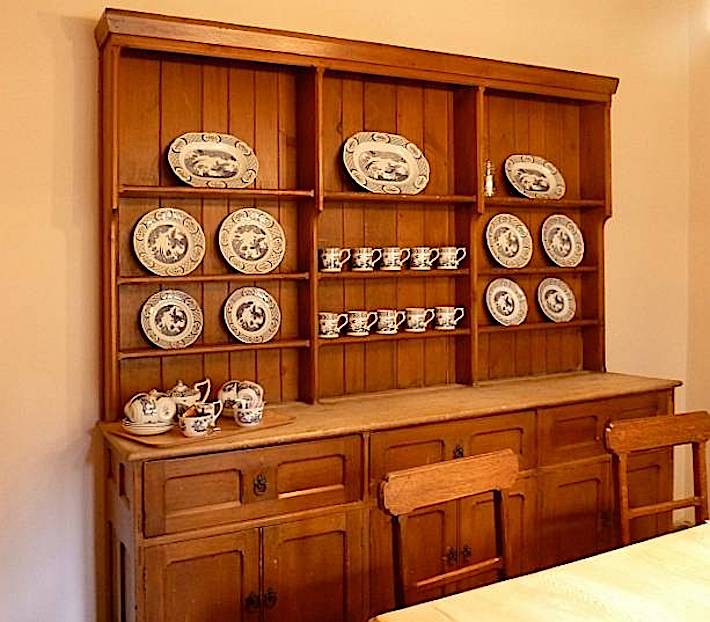
Left to right: (a) Portrait of Pugin, by J. R. Herbert; the original hangs in the Pugin Room, now used as a tea-room in the Houses of Parliament. (b) Corner of the dining room: the central shield over the fireplace shows the Pugin martlet and the Knill lion; the birds depicted on the fireplace look like martlets as well. (c) The only original piece of furniture in the house: the kitchen dresser.
Pugin was fond of interconnecting rooms, and the library opens into the drawing room (which also opens off the hall). Perhaps the most immediately eye-catching items in here are the companion portraits of Pugin and his third wife Jane, née Knill, reproductions of those by J. R. Herbert and G. A. Freezor respectively. Their gilded frames catch the lamplight, making them hard to photograph in their entirety. Herbert's portrait gives little idea of his subject's restless, driven personality, but does manage to hint at the mixture of the alert and the visionary in his nature. The panelled ceiling in here, like that in the library, has been restored, and the "En Avant" wallpaper faithfully copied from surviving scraps. Important original features are the windows (again, discussed separately), and the fireplace.
However, the latter is less impressive than the one in the dining-room on the other side of the hall, adjacent to the library. Though small, the dining room was another vital space for Pugin. "Like all men of vigour he had a strong appetite," says Powell, explaining that the larder of The Grange was always well stocked: "He liked nothing better than a roast leg of mutton, and on Family Feasts he would deal out with strict impartiality almonds and raisins, or a slice of cake' (15). Newman describes the fireplace in here as having "an excellently crisp chimneypiece under a hood stretching from side to side of the room" (425). The main relief on the stone shows St Augustine, the great Christian missionary who first landed in Kent, with angels on either side; the text on the long beam above is from the Magnificat.
Nearly opposite the dining room is the kitchen wing, the kitchen still sporting its original solid dresser. This is the kind of good "honest," functional but beautifully finished piece that would inspire William Morris, the very antithesis of the elaborate reception-room furniture produced by the High Victorian designers. Past the dining room on one side and the kitchen wing on the other is the little chapel and its sacristy, facing east, where the family gathered regularly for worship.
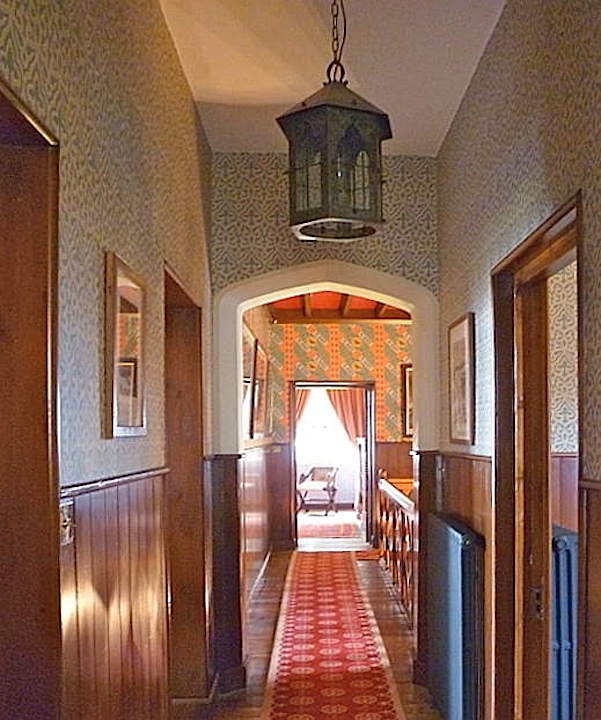
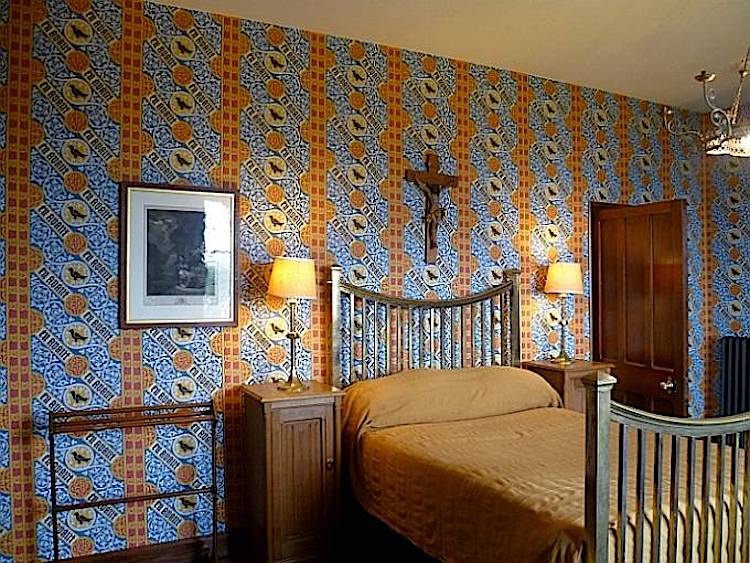
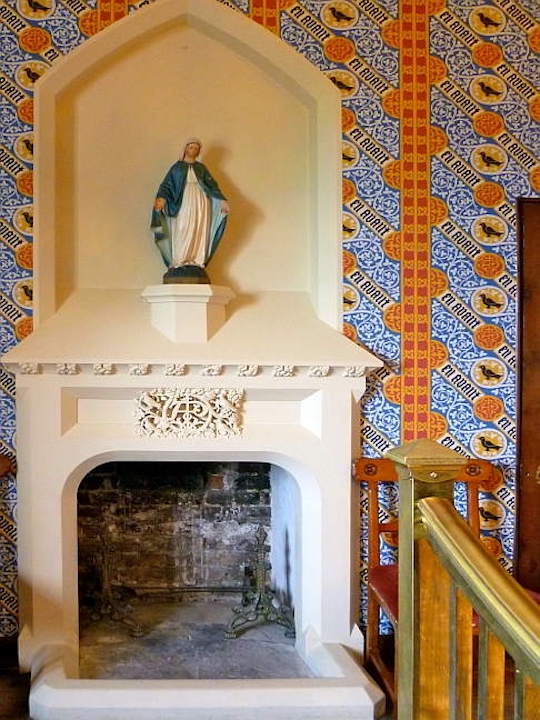
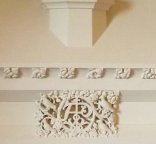
Left to right: (a) The passage from the landing, with light pouring in from every doorway; Pugin designed with such factors as light and vistas in mind, paying attention to the views framed by each window. (b) Pugin's bedroom, papered with the same blue "En Avant" wallpaper that was found in his wife's room, with which it connects. (c) The fireplace in Pugin's bedroom. (d) Detail of the fireplace hood; notice the Pugin martlets, and the motif created from intertwined initials.
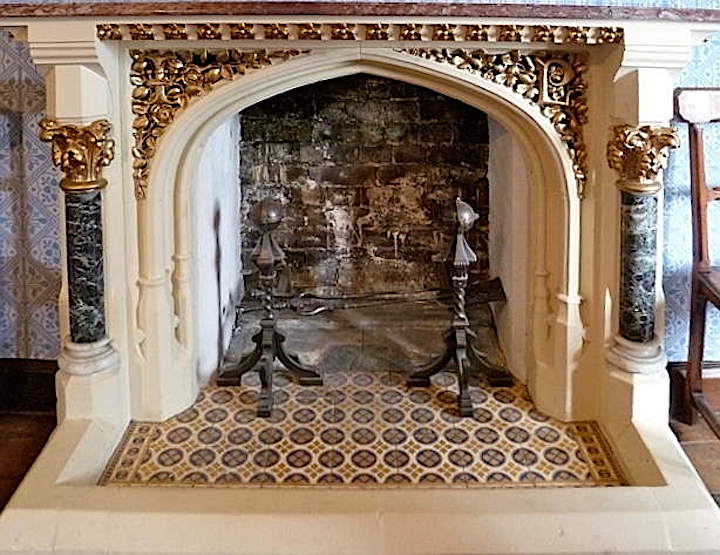
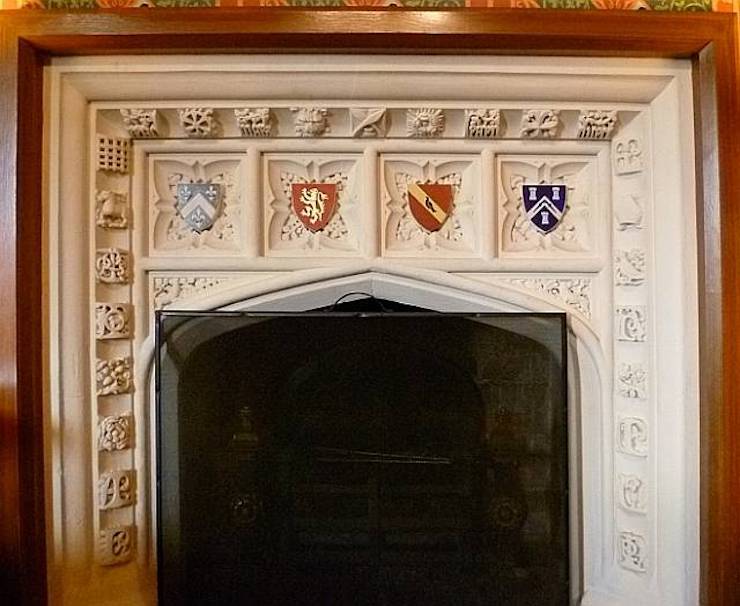
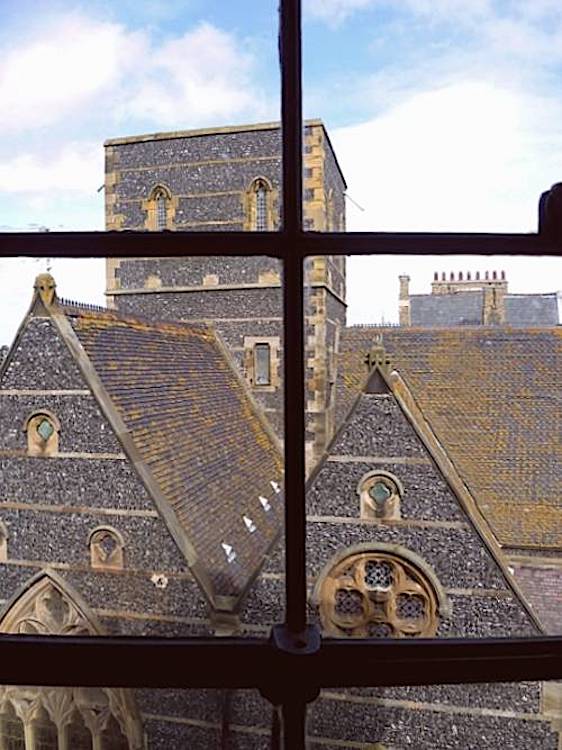
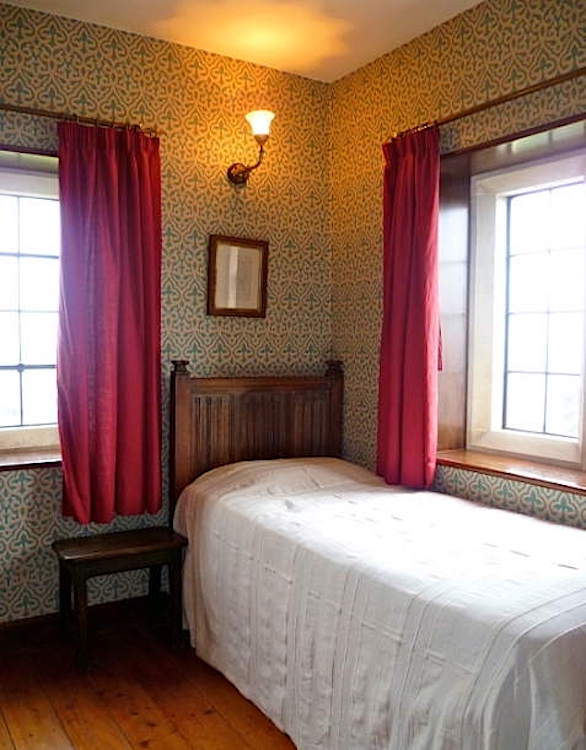
Left to right: (a) The much more ornate fireplace in Jane's bedroom, by Edward Pugin, immediately illustrative of his High Victorianism. (b) The original fireplace in the children's bedroom, with suitable nursery motifs, initials and family shields; in keeping with Pugin's sense of family togetherness, there was no separate nursery suite for the children. (c) View of St Augustine's Church from a window on the tower stairs. (d) John Hardman Powell's bedroom in the tower.
The plan for the upstairs rooms is equally "rational," with the long passage allowing Powell "peeps into differently coloured bedrooms, with their mullioned windows, quaintly carved fireplaces and furniture, all hung with old paintings, choice impressions of etchings and engravings, Durer being prominent" — as Powell concludes, "a treat for Artists" (13). Pugin's and his wife's bedrooms were linked by a short passage, possibly used as a dressing room. Edward Pugin's taste is more evident in Jane Pugin's bedroom than in any of the other rooms, since it has been deliberately preserved here in order to show the change in style after Pugin's death. Fireplaces like the one in here, removed elsewhere, "would have been anathema to Pugin with their faux-Corinthian capitals," writes Caroline Stanford (35). When Pugin settled down here, there were a dozen people in the household, including the children, the domestic help and the chaplain he engaged partly to tutor the eldest boy, Edward. Powell's arrival brought the number up to thirteen. He would alarm his master by reading in bed with a flickering candle, and by sleepwalking noisily in his little tower room: "the other night he knocked his head dreadfully in figting (sic) in his room," complained Pugin (qtd. in Wedgwood 6).
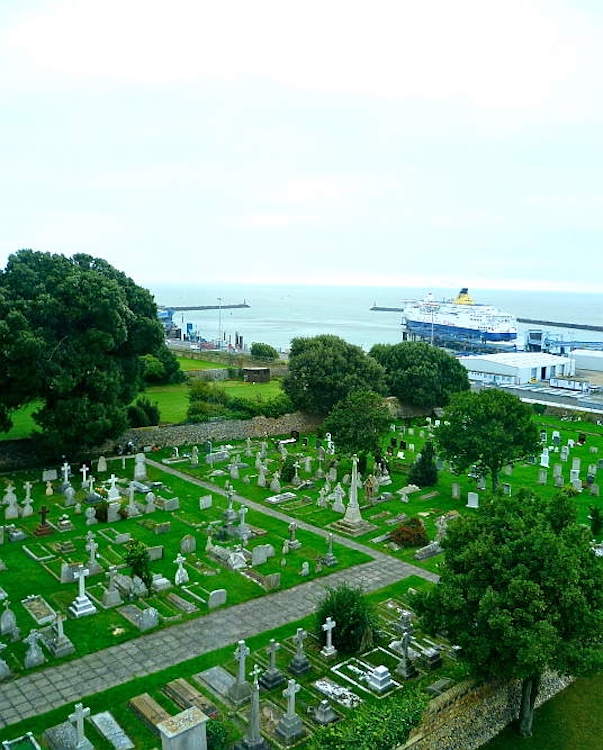
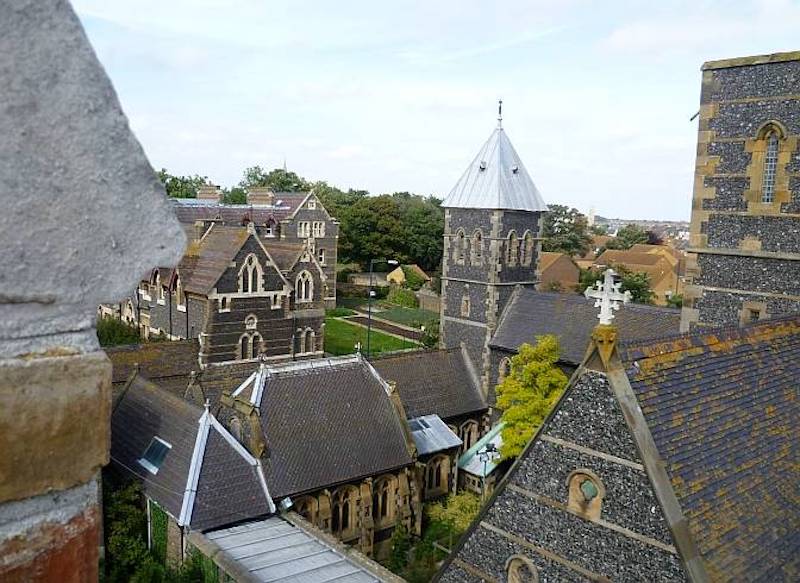
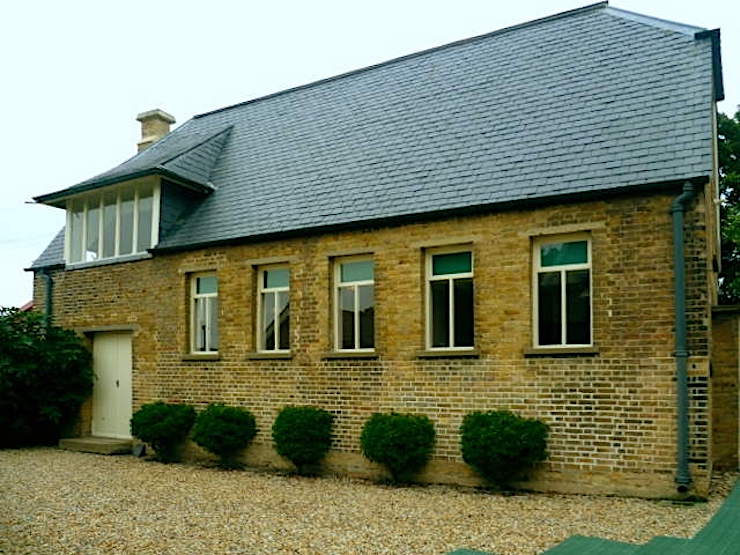
Left to right:(a) View from the tower across St Augustine's Churchyard, towards Ramsgate ferry terminal. (b) View from the tower across St Augustine's Church and part of the Abbey opposite (for which Edward Pugin built the residential block); note the different roofs for different parts of the buildings, (c) The Cartoon Room in front of the main house
Pugin would watch from the tower in rough weather, and put out to sea in his lugger Caroline on rescue and salvage missions. Some of the sailors who drowned, despite his and his crew's efforts, are buried in the churchyard. But the view inland is more telling: from this height one gets a better idea of the whole community that Pugin planned, where family life, work and worship could proceed hand in hand in harmony.That is not to say that there were no boundaries, because Pugin was a man who loved order in his daily routines, and this is reflected in his plans. "Each part of the building is treated as a separate unit, different in size and covered by a different roof," as Stefan Muthesius points out, praising the "picturesque utility" of the layout (6). Even this is only part of a much larger vision. In Pugin's delightful view of the yet-to-be completed site, painted to display at the Royal Academy in 1849, children are shown playing on the lawn behind the house, under the watchful eye of adults or maybe older children seated on a garden bench; a small funeral service is being held in the adjoining graveyard; and people work in the fields nearby. The Cartoon Room, an entirely separate small building in the courtyard, where stained glass was designed, and where Powell had his workshop, is also clearly visible (see Stafford 18-19). Pugin strove to carry through into his daily life this noble vision of work, pleasant sociabilty and worship amid the natural cycle. But, alas, he suffered greatly from the pressure of his own high standards, and increasing ill health. The tranquillity of the scene, like the tall spire which he awards his church, would prove as elusive for him then as it is for us today.
Related Material
- The stained glass windows in The Grange
- St Augustine's Church, Ramsgate
- Stained glass windows in St Augustine's Church
- St Augustine's Abbey
- "A Marvellous Man" (Review of Rosemary Hill's God's Architect: Pugin and the Building of Romantic Britain)
- "Augustus Welby Northmore Pugin" (by Charles L. Eastlake)
- St Marie's Grange, Aldebury
References
Hill, Rosemary. God's Architect: Pugin and the Building of Romantic Britain. London: Penguin, 2008.
Long, Helen C. Victorian Houses and Their Details: The Role of Publications in Their Building and Decoration. Oxford: Architectural Press, 2002.
Newman, John. North East and East Kent (Pevsner Architectural Guides: The Buildings of England). 3rd ed. London: Penguin, 1983.
Muthesius, Stefan. The High Victorian Movement in Architecture, 1850-1870. London: Routledge, 1972.
Powell, John Hardman. Pugin in His Home: Two Memoirs by John Hardman Powell. Ed. Alexandra Wedgwood. New enlarged edition. Ramsgate: The Pugin Society, 2006.
Stanford, Caroline. The Grange. Maidenhead: The Landmark Trust, 2008.
Wedgwood, Alexandra. Introduction. Pugin in His Home: Two Memoirs by John Hardman Powell, by John Hardman Powell.
Last modified 5 December 2010